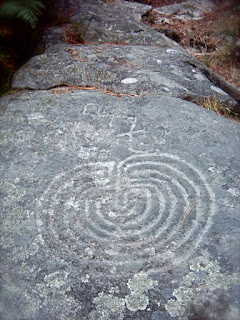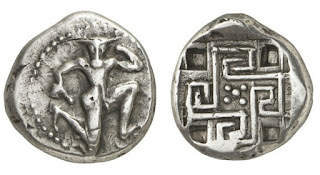The Triskeles symbol, otherwise known as the Triskelion, is a trilateral symbol consisting of three interlocked spirals. The triple spiral is found in artefacts of the Neolithic (7000 BC -1700 BC) and Bronze age (started with Aegean Bronze Age in 3200 BC - 600 BC) with continuation into the Iron Age specially in the context of La Tene culture and related Celtic traditions.
Roman Republic, The Pompeians, 49 BC, Triskeles with winged facing head of Medusa
Neolithic triple spiral symbol: Triskelion
The triple spiral symbol appears in many early cultures. In Malta (4400-3600 BC), in the astronomical calendar at the famous megalithic tomb of Newgrange in Ireland built around 3200 BC, which makes it older than the Egyptian pyramids, and on the Mycenaean vessels
Newgrange, in County Meath, was a passage tomb-built centuries before Egypt's Great Pyramids and features several triskelion designs
Beaked Jug (ewer) decorated with triple spirals. Late Helladic III, 1400-1350 BC
In Ireland, the triskelion is widely accepted as a Celtic symbol, but its origins predate even the arrival of the Celts in the British Isles. It gained popularity from 500 BC onwards, the same time that Buddhism evolved in India
Newgrange Chamber showing the Tri-Spiral engraving
The triskeles, composed of three human legs, is younger than the triple spiral and is found on Greek pottery and later also minted on Greek and Anatolian coinage. The three legs of the triskelion seem to move outwards from the center suggesting motion and the cyclicality of nature.
The first instances of triskelion featured three bent legs. The image is commonly found in the Mediterranean Island of Malta (Shepard/ Flickr)
It is also found on the shield of Achilles in an Attic hydria of the late 6th century BC. It is found on the coinage in Lycia and the Mahajanapada coins of India in the 6th to 5th century BC.
Late examples of the triple symbols are found in Iron age Europe in the carved in rock in Castro Culture settlement in Galicia, Asturias and Northern Portugal. In Celtic Christianity, the symbol took a new meaning, as a symbol of the Trinity (Father, Son and Holy Spirit)
Triskelion of the oppidum of Coeliobriga (Galicia)
The triple spiral design is found as the arms of the King of Mann (1280 AD) and as canting arms in the seal of Bavarian city of Fussen (1317 AD).
Arms of Sir John I Stanley of the Isle of Mann, 1414 AD, first Stanley King of Mann
The flag of Sicily has the triskeles and Gorgoneion symbol
Flag of Sicily
Buddhist symbol. The triskelion symbol is also a Buddhist meditational symbol. Triskeles are frequently seen in the center of Dharma wheels, four pronged vajras and auspicious symbol mandalas
There are various interpretations about the meaning of the symbol. Some thought of earth, water and sky, or life, death and rebirth, or past, present and future, physical, spiritual and celestial, mind, body and spirit, creation, preservation and destruction and many more.
The spirals found on ancient tombs have been drawn in one continuous line and speculate that this represents life and death
Spirals on ancient tombs, signifying life, death and rebirth
By the 5th century, when Ireland and the British Isles were the last two strongholds of Celtic culture, the symbol was incorporated seamlessly into Christian iconography as it was identified as the Holy Trinity. It found its way in famed illustrations in the ''Book of Kells'', and. on windows of Golthic cathedrals all over Europe
Today in addition to decorating the flags of Sicily and the Isle of Mann, it is also the insignia of the Irish Air Corps.
Irish Air Corps uses a white, orange and green triskelion
In Japanese Shinto culture, the deity Hachiman (the god who instructs war) has a triskelion like symbol called a ''tomoe''. One of the symbols of Tibetan Buddhism called a ''Gankyil'', a triple spiral called a ''wheel of joy'' and represents ground, path and fruit or desire, hatred and ignorance, or learning, reflection and meditation. The Korean ''Taegeuk'' is of a similar design and is associated with both Korean Daoism and shamanism.
Buddhist Meditation Emblem with a triskele in the center
The triskelion's worldwide spread since ancient times is well known, however it is still widely recognized as a Celtic symbol.
Celtic and Buddhist Symbolism. Very interesting research leads to Saint Origen's (184-253 AD), who was an early Christian scholar and has been described as the greatest genius the early church ever produced) statement that Buddhists and Druids (Druids were members of the high-ranking class in Celtic culture as religious leaders and legal authorities) co-existed in pre-Christian Britain and Ireland. Ashoka's missions spreading Buddhism as far as Europe, probably influenced the Druids, who also had similar beliefs. Buddhist teachings slowly integrated into the Celtic culture, and before Christianity spread in Britain and Ireland, these symbols got integrated. Pages 42 and 43 of the book titled ''Buddhism in the Celtic Area'' state the confluence of the two
Triskeles on Coins
Roman Republic, The Pompeians, 49 BC, denarius, weight 3.8 g
Obverse: Triskeles, with winged facing head of Medusa, at center, ear of grain between each leg
Reverse: Jupiter standing right, holding thunderbolt and eagle, harpa to right
Wekhssere I,460-435 AD, Trihemiobol, Patara, weight 1.3 g
Obverse: Head of Athena right wearing helmet
Reverse: Triskeles within dotted frame in incuse square
Obverse: Lions scalp facing
Reverse: Triskeles to left, draped bust of Apollo, facing left, all within incuse
Thessaly, Larissa, 5th century BC, Hemiobol, 0.4 g
Obverse: Bull's hoof, border of dots
Reverse: Triskeles with the face of a gorgoneion, two snakes emerge from the top of its head, all in an incuse
Pamphylia, Aspendo, 465-430 BC, Oboi, weight .94 g
Obverse: Vase with handle
Obverse: 4 punches, elephant left, triskeles surrounded by pellets and taurine symbol in square
Obverse: Punches showing six-armed symbol sun, bull, rabbit upon the five arched hill, two circles placed side by side and surrounded by eight taurines
Reverse: Triskele and other indistinct symbols
Obverse: Triskele with crescent and dots
Reverse: six-armed symbol
India, Kuntala Janapada, 650-450 BC, 1/2 shatamana, weight 6.8 g
Obverse: Pulley design, triskele above
Reverse: blank
India, Malla Janapada, 500-400 BC, 1/2 karshapana, weight 2.03 g
Obverse: triskeles and a symbol
Reverse: Undertype with floral symbol



















































